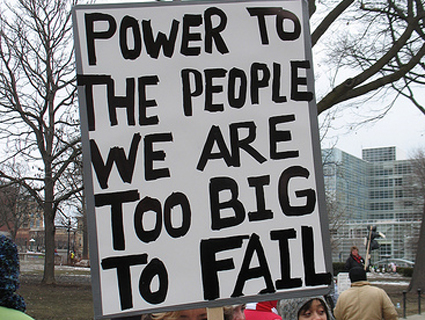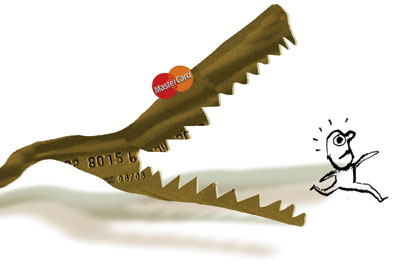The San Francisco “poet, editor, and marketer” in the video below has a sneaky, Occupy Wall Street-inspired idea: When banks send you unsolictited credit card applications, use the postage-paid envelope to send them a bunch of junk, making them pick up the extra postage costs. It’s not just about nickel and diming Wall Street into submission, he says, “The real effect of this is to force banks to react to us.”
If you can send an envelope filled with paper, wood shims, and roofing shingles, could you affix the postage-paid envelope to, say, a brick? A site called Office of Strategic Influence has a guide for sending heavy objects back to junk mailers:
You know those obnoxious “refinance your home” or credit card
scamsoffers that you get in the mail? This is called direct marketing, where marketers use a reduced bulk postal rate to send entire forests of paper mail to you.So this is something you can do in response.
Find a shoebox, or a storage bin, or any cardboard box you have laying around. Fill it up with bricks, big blocks of iron, or maybe cement. Tape the box up with everyday packaging tape. Use a junkmail’s postage-paid envelope and tape it neatly to the top cover of the box. NEATLY. And mail it off. Envelope revenge!
The site claims that a sending an eight-pound package with prepaid postage will cost the receiver $25. (It also maintains that “[i]f we do this enough, the USPS will make so much money, that they will lower postage costs.”)
But can you really get away with this? Believe it or not, Americans have been pissed off about junk mail since at least 1984, which is when this very question was posed to Straight Dope columnist Cecil Adams. His conclusion:
Unfortunately, your bricks-for-business scheme, admirable though it is in theory, won’t work in practice. According to rule 917.243(b) in the Domestic Mail Manual, when a business reply card is “improperly used as a label”—e.g., when it’s affixed to a brick—the item so labeled may be treated as “waste.” That means the post office can toss it in the trash without further ado.
Sure enough, current postal regulations state that business-reply mail “may not be used for any purpose other than that intended by the permit holder, even when postage is affixed.” In other words, if you mail a boxload of bricks to Citibank, it may not reach its intended destination. But would a postal employee notice a really fat business-reply envelope? Probably not, right? So then the question is, how many overstuffed envelopes will it take for a bank to take notice that someone is trying to send a message?
Update: An astute reader notes below that the mail-a-brick trick can be traced back to Abbie Hoffman, who advocated it in Steal This Book:
Those ridiculous free introductory or subscription type letters that you get in the mail often have a postage-guaranteed return postcard for your convenience. The next one you get, paste it on a brick and drop it in the mailbox. The company is required by law to pay the postage. You can also get rid of all your garbage this way.
Also, a relation who’s worked in the mail-processing business informs me that banks would be unlikely to notice any junk being sent to them, since their incoming credit-card applications are likely handled by contractors. Likewise, mass mailers may pay flat fees for their return postage, which means that a brick is unlikely to weigh on the conscience of a banking executive.
And Artie Moffa, the maker of the video above, has officially come out against mailing bricks, bowling balls, and rabid alligators. His advice: Stick to stuffing envelopes.
















